
Subtitled “Ocean Ways, Asian Paths,” this exhibition takes visitors back in time to experience Japan’s history of cultural exchange with Asia and Europe.
Since antiquity, Kyushu has been an important center of exchange between Japan and continental Asia by virtue of its proximity to the Korean Peninsula. Situated in this historically significant region, our Cultural Exchange Exhibition examines how Japanese culture formed with reference to its place in Asia’s history.
Occupying around 3,900 square meters of floor space, the Cultural Exchange Exhibition Hall is divided into five big themes covering Japan’s history from the Paleolithic period to early modernity in the nineteenth century. The main exhibition space features key objects representing cultural exchange during each period, and is also surrounded by eleven themed rooms that delve deeper into historically significant aspects of cultural exchange. Exhibits are constantly rotated to provide visitors with fresh content and perspectives, and interactive displays allow visitors to experience history in a multisensory way.
Five Main Themes
Theme 1 —Jōmon Culture: Ocean-Bound
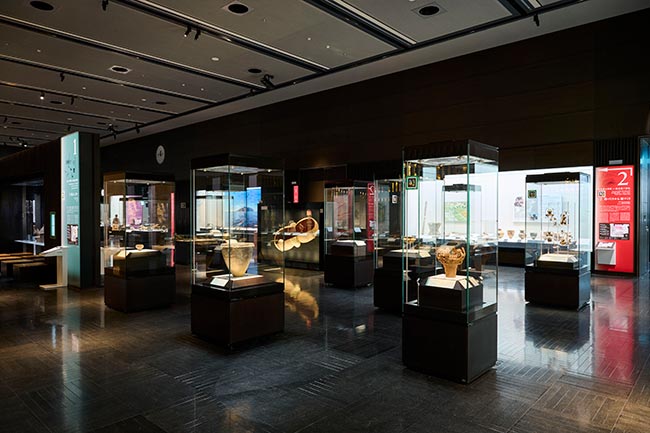
(35,000 years ago to 4th century BCE)
In the Paleolithic Ice Age, people led nomadic lifestyles, hunting large animals and gathering plants. When the climate grew warmer, forests began bearing nuts and fruits, the seas grew rich in fish, and small animals came into existence. People began to settle in one place, making earthenware for cooking, decorating their surroundings, offering prayers, and holding funerals. The abundance of foods such as salmon in eastern Japan provided the foundation for the blossoming of what we now know as Jōmon culture.
Theme 2 —Political Power: Cultivating Rice
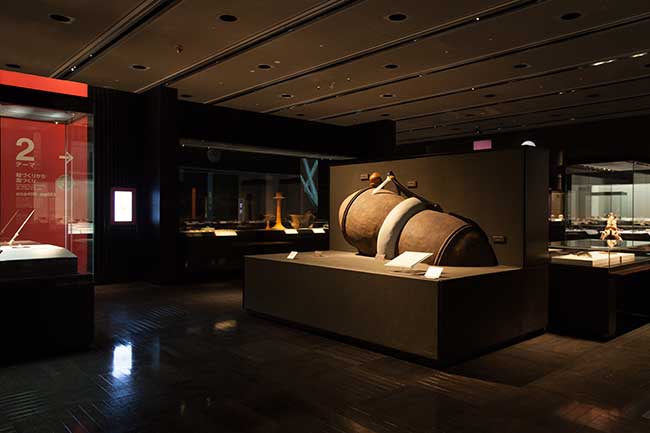
(4th century BCE–7th century CE)
Rice cultivation and metalwork arrived in Kyushu from the Asian continent at the beginning of the Yayoi period. People began working together to farm, and leaders soon emerged to oversee tasks, eventually becoming kings that ruled the area. During the Kofun period, most of the Japanese archipelago came under the rule of a “Great King,” who ruled over other local leaders. People continued coming to Japan from mainland Asia, bringing with them horseback-riding culture and sue pottery–making techniques. The Kyushu region also developed a unique culture of decorating burial mounds, which we now call kofun (ancient tumuli), with stone statues and colorful murals.
Theme 3—Nation Building: The Age of the Envoys
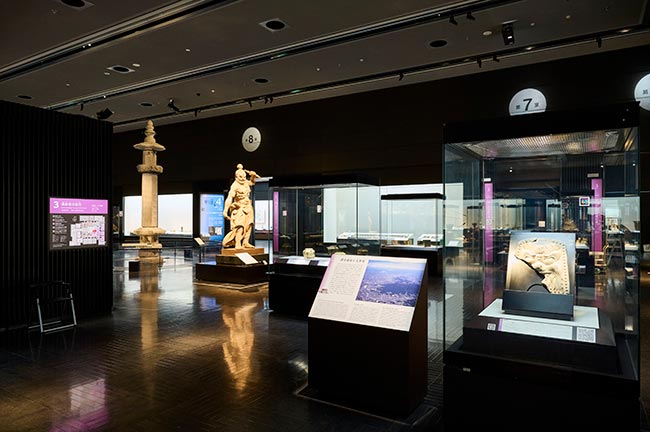
(7th–12th century)
In the Nara period, Japan began sending envoys known as kentōshi to Chang’an, the capital of Tang China, to learn about the nation’s advanced governmental system and Buddhism. These envoys then brought back various ideas and objects via Dazaifu, making it a center for diplomacy and trade with other Asian countries. In the subsequent Heian period, locals built on these foreign influences and cultures to create new, uniquely Japanese cultural practices, such as a new script known as kana. New forms, beliefs, and practices of Buddhism also made their way to Japan during this era.
Theme 4—Merchants of the Asian Seas
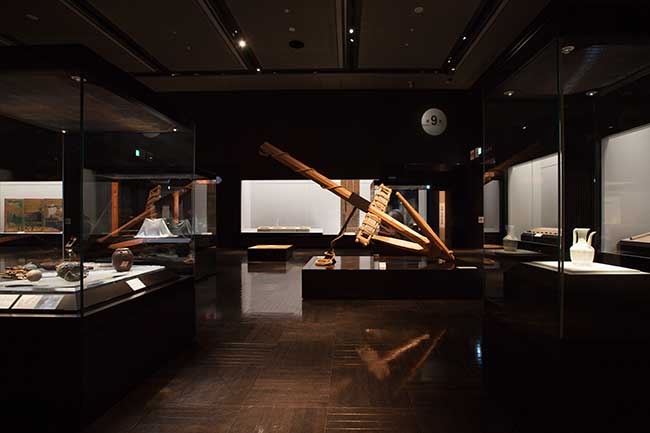
(12th–16th century)
The samurai class rose to power in the Kamakura period, marking the beginning of what some scholars refer to as a longer, “medieval period” that lasted through the Muromachi period. During this era, Asian merchants frequently sailed the seas and traded with one another. Commerce developed in many cities in Japan, including Fukuoka’s Hakata, and Kyoto. At the same time, Zen monks brought over art forms like ink paintings and tea-drinking, which became symbols of wealth and power among the samurai, even as they constantly battled for supremacy. These eventually developed into tea ceremonies, a symbol of traditional Japanese culture today.
Theme 5—Smaller World, Closer West
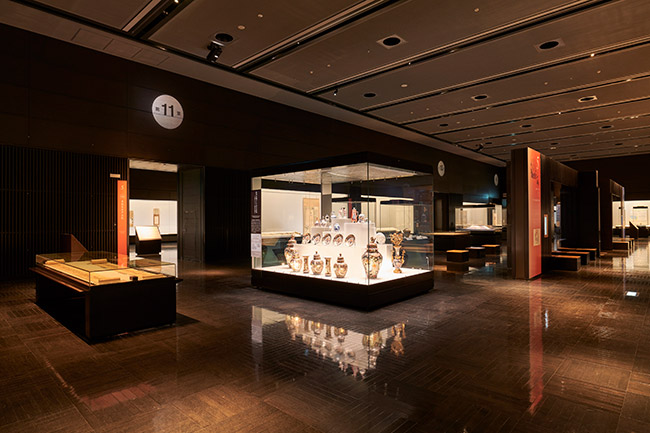
(16th–19th century)
The European Age of Discovery coincided with the end of the Muromachi period through the Azuchi-Momoyama period in Japan. European traders set foot on Asian soil, bringing guns and Christianity to Japan, and leaving with Japanese silver and crafts. Although Japan famously entered a period of national isolation during the subsequent Edo period, the nation actually maintained trade with the outside world via four windows: Nagasaki, Tsushima, Ryukyu (present-day Okinawa), and Ezo (present-day Hokkaido). As Japanese ceramics and lacquerware captured hearts overseas, locals were introduced to new knowledge and technology from Europe, paving the way for Japan’s modernization.
Eleven Adjoining Rooms
Room 1 Donors’ Gallery
This exhibition room features valuable objects that have been generously donated to us. Some of the must-see items include a bottle with pine, bamboo and palm motifs in polychrome overglaze enamels, and Katsushika Hokusai’s Daily Sketches for Exorcism and Longevity.
Room 2 Kaneko Kazushige Memorial Gallery: Asian Ethno-forms
Named for Kaneko Kazushige’s generous donation of over 1,000 valuable objects relating to Asian cultures and lifestyle practices, this gallery has been permanently dedicated to displaying a selection of these items, which paint a colorful picture of Asia.
Theme 2—Political Power: Cultivating Rice
Room 3 The Emergence of the Ancient Japanese in East Asia
During the Yayoi period, rice farming took root in northern Kyushu, where people also traded metals and other resources. This room presents artifacts left behind by these imported cultures as well as technologies which contributed to the formation of Japanese civilization.
Room 4 The Ancient Tombs: Colorful Murals and Ornaments
Enter a room filled with haniwa terracotta figurines and stone figures that once stood around ancient tumuli as decoration. Also on display are photographs and replicas of beautiful murals found inside the same tumuli, reflecting the aesthetics of ancient people living in northern and central Kyushu.
Room 5 Screening Room: Ornamented Ancient Tumuli
Though most ancient tumuli are out-of-bounds today, visitors can now simply enter this theater and take a virtual tour of a stone chamber that has been digitized using the latest technology.
Theme 3—Nation Building: The Age of the Envoys
Room 6 Image of Ideal Asians
This room is dedicated to showcasing depictions of deities or targets of worship in various religions all over the Asian continent. In particular, visitors can expect to learn about Buddhist art and its development in Asia.
Room 7 A Short Trip to Asia
The limits of political boundaries and time do not apply in this room, where we showcase a selection of artifacts that allows visitors to learn more about certain aspects of cultures all over Asia.
Room 8 The Voyage of the Envoys and the Silk Road
Besides displaying objects from places along the Silk Road, this room also comes with an interactive display that allows visitors to touch and smell the cloths and spices that traveled the Eurasian continent and came to Japan via envoys to Tang China.
Theme 4—Merchants of the Asian Seas
Room 9 The Exchanges of People and Objects during the Middle Ages
The exhibits in this room present regional variations that have developed in cultural elements common to various Asian nations as a result of trade and travel.
Theme 5—Smaller World, Closer West
Room 10 Ceramics of Kyushu: The Tanakamaru Collection
Visitors can feast their eyes on some of the finest works from Tanakamaru Zenpachi’s collection of Kyushu ceramics, which are on display in this room.
Room 11 Edo: A Multifaceted Culture
Edo-period Japan saw the blossoming of fine arts and crafts all over the nation. This room features a selection of these works, produced in local regions such as Nagasaki and Ryukyu.